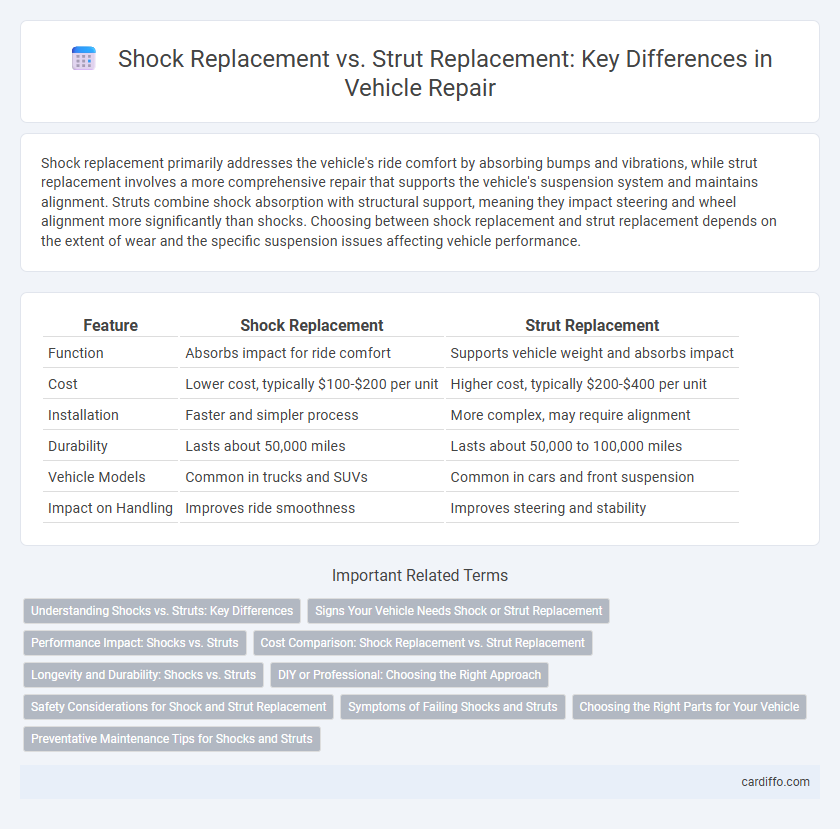Shock replacement primarily addresses the vehicle's ride comfort by absorbing bumps and vibrations, while strut replacement involves a more comprehensive repair that supports the vehicle's suspension system and maintains alignment. Struts combine shock absorption with structural support, meaning they impact steering and wheel alignment more significantly than shocks. Choosing between shock replacement and strut replacement depends on the extent of wear and the specific suspension issues affecting vehicle performance.
Table of Comparison
| Feature | Shock Replacement | Strut Replacement |
|---|---|---|
| Function | Absorbs impact for ride comfort | Supports vehicle weight and absorbs impact |
| Cost | Lower cost, typically $100-$200 per unit | Higher cost, typically $200-$400 per unit |
| Installation | Faster and simpler process | More complex, may require alignment |
| Durability | Lasts about 50,000 miles | Lasts about 50,000 to 100,000 miles |
| Vehicle Models | Common in trucks and SUVs | Common in cars and front suspension |
| Impact on Handling | Improves ride smoothness | Improves steering and stability |
Understanding Shocks vs. Struts: Key Differences
Shocks primarily control the up-and-down movement of your vehicle, enhancing ride comfort by dampening road vibrations, while struts combine shock absorption with structural support for the suspension system, influencing steering and alignment. Replacing shocks is generally simpler and less expensive, suitable for maintaining ride quality, whereas strut replacement is more complex, often requiring wheel alignment to restore proper vehicle handling. Understanding these functional differences helps in making informed repair decisions that optimize vehicle safety and performance.
Signs Your Vehicle Needs Shock or Strut Replacement
Uneven tire wear, excessive bouncing, and poor handling are common signs indicating your vehicle needs shock or strut replacement. Noticeable fluid leaks on the shocks or struts and increased stopping distances also signal worn suspension components. A thorough inspection by a certified mechanic can accurately diagnose the need for replacement to restore optimal vehicle safety and performance.
Performance Impact: Shocks vs. Struts
Shock replacement primarily enhances ride comfort by absorbing road vibrations, while strut replacement significantly improves vehicle stability and steering control due to its integral role in the suspension system. Struts combine shock absorption with structural support, influencing alignment and handling, leading to a more responsive driving experience compared to shocks alone. Neglecting strut wear can cause uneven tire wear and compromised braking performance, highlighting the critical performance impact of timely strut replacement over shocks.
Cost Comparison: Shock Replacement vs. Strut Replacement
Shock replacement typically costs between $150 and $300 per shock, whereas strut replacement ranges from $300 to $700 due to the strut's integrated coil spring and additional labor. The higher price of strut replacement reflects the more complex assembly and the need for precise alignment after installation. Comparing these costs helps car owners make informed decisions based on budget and vehicle suspension requirements.
Longevity and Durability: Shocks vs. Struts
Shock replacement typically offers a shorter lifespan compared to strut replacement due to the simpler design and fewer integrated components. Struts provide enhanced durability and longevity by combining shock absorption with structural support, resulting in improved vehicle stability over time. Investing in strut replacement often leads to longer-lasting performance and reduced maintenance frequency compared to shocks alone.
DIY or Professional: Choosing the Right Approach
Shock replacement often suits DIY enthusiasts due to simpler installation and lower risk of alignment issues compared to strut replacement, which typically requires professional expertise and specialized tools to handle complex suspension components and ensure proper vehicle alignment. Professional strut replacement ensures safety and optimal performance by addressing structural integration and mitigating potential damage from improper handling. Evaluating skill level, tool availability, and vehicle suspension design is essential when deciding between DIY shock substitution and professional strut servicing.
Safety Considerations for Shock and Strut Replacement
Choosing between shock replacement and strut replacement significantly impacts vehicle safety, as shocks control ride quality while struts contribute to structural integrity and steering stability. Worn shocks or struts can lead to reduced braking efficiency, poor tire contact with the road, and increased risk of accidents due to compromised handling. Ensuring timely replacement with manufacturer-recommended parts maintains optimal suspension performance, preventing potential safety hazards caused by uneven tire wear and loss of traction.
Symptoms of Failing Shocks and Struts
Symptoms of failing shocks and struts include excessive bouncing, uneven tire wear, and poor vehicle handling, which compromise safety and ride comfort. Drivers may notice increased stopping distances, nose-diving during braking, or swaying during turns, indicating worn suspension components. Early diagnosis and replacement help maintain stability, prevent further damage, and ensure optimal suspension performance.
Choosing the Right Parts for Your Vehicle
Selecting the right parts for your vehicle requires understanding the difference between shock replacement and strut replacement, as struts integrate the shock absorber with suspension components like the coil spring, affecting ride height and alignment. Choosing strut replacement is essential when structural suspension components are worn or damaged, while shock replacement suits vehicles with separate shock absorbers where ride quality is the primary concern. Using OEM or high-quality aftermarket parts ensures durability, proper fitment, and optimal vehicle handling performance.
Preventative Maintenance Tips for Shocks and Struts
Regular inspection of shocks and struts helps identify wear early, preventing further suspension damage and costly repairs. Replacing shocks alone can improve ride comfort, but opting for complete strut replacement ensures restored structural integrity and optimal vehicle handling. Maintaining proper tire pressure and avoiding potholes extends the lifespan of shocks and struts, enhancing overall suspension performance.
shock replacement vs strut replacement Infographic

 cardiffo.com
cardiffo.com